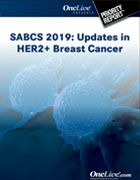Taxane Choice With Pertuzumab/Trastuzumab in HER2+ MBC Does Not Affect Outcome
The combination of pertuzumab and trastuzumab plus paclitaxel is commonly being used in the community for the treatment of patients with HER2-positive breast cancer, and appears to be as effective as pertuzumab and trastuzumab plus docetaxel according to real-world findings from a retrospective cohort study.
Letizia Polito, PhD

Letizia Polito, PhD
The combination of pertuzumab (Perjeta) and trastuzumab (Herceptin) plus paclitaxel (PHP) is commonly being used in the community for the treatment of patients with HER2-positive breast cancer, and appears to be as effective as pertuzumab and trastuzumab plus docetaxel (PHD) according to real-world findings from a retrospective cohort study reported at the 2019 San Antonio Breast Cancer Symposium (SABCS).1
In the study, the median real-world progression-free survival (rwPFS) was 12.9 months (95% CI, 11.2-15.8) for PHP and 14.9 months (95% CI, 13.2-16.9) for PHD.
Time to last administration (TTLA) was used as a proxy for treatment duration for PH and chemotherapy. The median TTLA of the index taxane was 3.7 months (range, 3.42-3.91) in the PHP group versus 3.5 months (range, 3.45-3.45) in the PHD group. The median TTLA of PH was 10.6 months (95% CI, 8.51-11.8) for PHP and 11.8 months (95% CI, 10.49-13.3) for PHD.
No statistically significant difference was found between PHP and PHD for TTLA of PH and for rwPFS, either in the unadjusted models or in the models adjusted for potential confounders.
“The potential difference in the effectiveness of the PHD versus the PHP regimen was not large enough to be observed in the study cohort, regardless of the statistical adjustment used, supporting the evidence from the PERUSE trial (NCT01572038),2 suggesting that paclitaxel appears to be a valid alternative taxane backbone to docetaxel, and extending the evidence to a more heterogeneous population,” the investigators, led by Letizia Polito, PhD, wrote in their poster presentation.
“This confirmed in the real world that the 2 treatments are equally effective, which is what we expected,” Polito, a real-world data scientist, biostatistician, and epidemiologist, of F. Hoffmann-La Roche Ltd., said in an interview with OncLive at SABCS.
“No previous data in the real world have shown that the 2 treatments are comparable in terms of treatment duration and PFS. Treating with either docetaxel or paclitaxel in a pertuzumab-based regimen made no difference on outcome, but we know that paclitaxel has a better safety profile,” Polito added. “We also adjusted for potential confounding variables, we accounted for all the imbalances in the baseline characteristics, and observed that the rwPFS curves between paclitaxel and docetaxel are even more overlapping.”
The nationwide Flatiron Health Electronic Health Record (EHR)-derived database was used to identify 1054 patients who received a taxane with PH as initial systemic therapy after diagnosis of metastatic breast cancer between June 1, 2012 and April 30, 2019.
“In the real world, it still seems like docetaxel is the preferred option, but paclitaxel is increasingly being used together with pertuzumab and trastuzumab,” said Polito. Of the 1054 patients, 29.3% received PHP (26.9% paclitaxel and 2.4% nab-paclitaxel [Abraxane]) and 70.7% received PHD.
The median age of the overall cohort was 59.0 years (range, 51-67). ECOG performance status was missing in 42.9% of patients; of the remaining patients for whom ECOG performance status data were available, 31.3% had a status of 0, 19.4% a status of 1, and 6.5% a status of ≥2. Almost half (45.7%) of the participants had 1 metastatic site, 32.3% had 2, and 21.5% had ≥3. Furthermore, 46.5% of participants had recurrent disease.
The median time since initial breast cancer diagnosis was 46.2 months (range, 29.4-84.5). About three-fourths (70.8%) of patients had estrogen receptor— or progesterone receptor–positive disease, and nearly all cases (93.5%) were from the community setting.
In both the patients with de novo disease (n = 564) and the patients with recurrent disease (n = 490), those treated with PHD were more often treated in the community setting as compared with those treated with PHP. Specifically, 95.4% of patients with de novo disease were treated with PHD in the community setting versus 83.2% of those treated with PHP; of the patients with recurrent disease, 97.6% and 90% were treated in community practice with PHD and PHP, respectively.
Among the patients with de novo disease, those treated with PHP were significantly older (P = .001), had an ECOG performance status of 0 less often (P = .002), and were more likely to have metastatic sites (P = .007) than those treated with PHD. An ECOG performance status of 0 was also less likely in the patients with recurrence who were treated with PHP compared with PHD (P = .03).
Fifty-four (5.1%) patients switched taxane during first-line therapy, 15 (5.3%) of whom switched from paclitaxel to nab-paclitaxel and 39 (5.2%) of whom switched from docetaxel to either paclitaxel or nab-paclitaxel. No patient switched from paclitaxel or nab-paclitaxel to docetaxel.
One limitation to the study was that the analysis only included patients who were part of the Flatiron Health network; this could result in potential selection bias—due to different coverage of different geographic areas in the United States or because of an imbalance between academic and community settings—in favor of community settings, according to the investigators. Furthermore, results may have been impacted by unmeasurable and unobserved confounding.
References
- Polito L, Shim J, Du Toit Y, et al. Use of pertuzumab in combination with taxanes for HER2-positive metastatic breast cancer (MBC): analysis of US electronic health records. Presented at: 2019 San Antonio Breast Cancer Symposium; December 10-14, 2019; San Antonio, TX. Abstract P1-18-14. bit.ly/2S7qtyu.
- Bachelot T, Ciruelos E, Schneeweiss A, et al. Preliminary safety and efficacy of first-line pertuzumab combined with trastuzumab and taxane therapy for HER2-positive locally recurrent or metastatic breast cancer (PERUSE). Ann Oncol. 2019;30(5):766-773. doi: 10.1093/annonc/mdz061.
Nonrandomized trials had already suggested the utility of PHP as an alternative to PHD.




